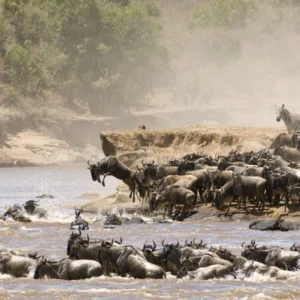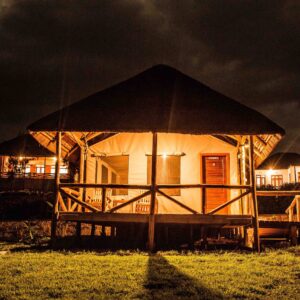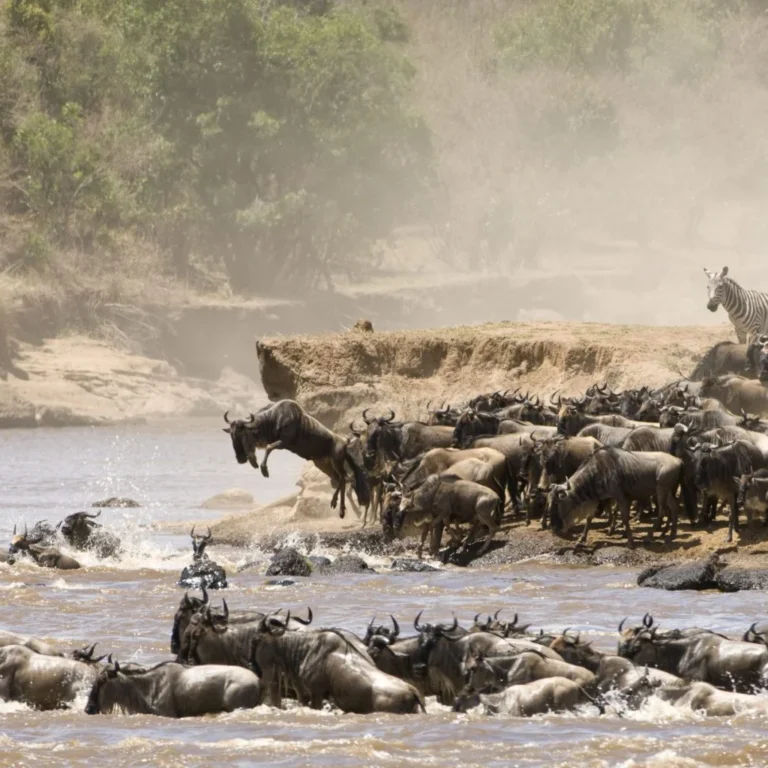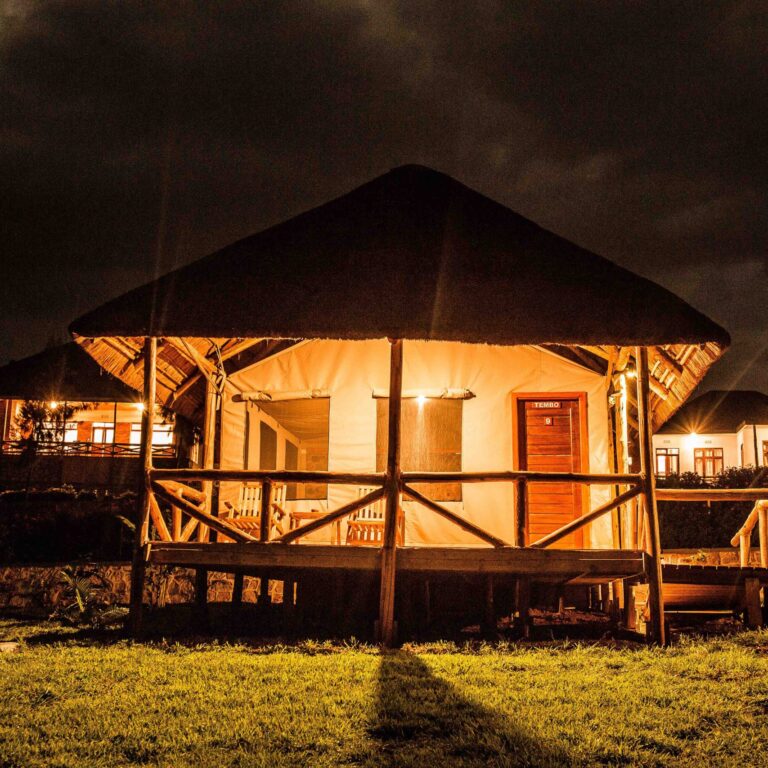When is Best Time To Visit Tanzania (Month by Month).
Tanzania is a country of stunning landscapes, diverse wildlife, and rich cultural heritage. Knowing the best time to visit Tanzania can significantly enhance your experience, whether you’re there for a safari, a cultural tour, or a beach holiday. The best time to visit Tanzania for a safari is during the dry season from late June to October. Tanzania has two distinct rainy seasons: April to May (the long rains) and November to December (the short rains). June to August is the best time for a safari in Tanzania. The spectacular Mara River crossing occurs June-July and drier weather means more wildlife around waterholes. That said, the Great Migration swirls around the Serengeti outside these months; you just have to follow its course. Here, we break down the best times to visit Tanzania month by month to help you plan your trip perfectly.
Best Time: June to October (All parks), January to February (Serengeti for the wildebeest calving)
High Season: July to March (Northern circuit parks; all get crowded), June to October (Southern and Western circuit parks; only Nyerere gets crowded)
Low Season: April and May (many lodges are closed in the Southern and Western circuit parks)
Best Weather: June to October (Little to no rainfall)
Worst Weather: March to May (Peak of the Wet season)
Tanzania in January
January in Tanzania is characterized by warm weather and occasional short rains start of the green season. This is an excellent time to visit the Serengeti for the calving season. Thousands of wildebeest calves are born, attracting predators and offering dramatic wildlife viewing. Ngorongoro Crater is lush and green, with fewer tourists, making it a prime spot for observing wildlife in a more tranquil setting. The Great Migration is in full swing, providing spectacular wildlife viewing opportunities. Additionally, the Zanzibar Archipelago enjoys warm weather, perfect for beachgoers.
What’s the weather like in Tanzania in January? In the mainland, the average temperature ranges from a cool 16°C to a warm 29°C, so it’s ideal to pack some warm clothes along with your summer style! On our islands, you can expect a balmy 23°C to a hot high of 32°C, so whip out the sunscreen!
Tanzania in February
February continues the calving season in the Serengeti. The weather remains warm and pleasant, making it a fantastic time for game viewing. Bird watchers will enjoy this period as migratory birds are abundant. Tarangire National Park is another great destination, where you can witness large herds of elephants and the rare tree-climbing lions. February continues the green season with more wildlife action.
The Serengeti is bustling with life as thousands of wildebeest give birth, attracting predators like lions and hyenas. This month offers unparalleled opportunities to witness the cycle of life in the wild. For those interested in cultural experiences, visiting the Maasai villages can be particularly rewarding.
The weather in Tanzania in February can range from pleasant to very hot, depending on where you visit. The maximum average temperature in Tanzania in February is 31°C (88 °F) during the day, while the minimum average is 25 °C (77 °F) at night.
Tanzania in March
March marks the beginning of the long rains. While the rains can make some roads impassable, the landscapes become incredibly lush and vibrant. This is an excellent time for photography. The Selous Game Reserve and Ruaha National Park offer unique experiences with fewer tourists. Prices for lodges and safaris are generally lower, making it a good time for budget travelers. March sees the beginning of the long rains, leading to fewer tourists and quieter parks.
However, this can be an ideal time for those seeking a more tranquil experience. The landscapes are lush and vibrant, and the birdlife is exceptional, with many migratory species present. Lake Manyara National Park is a haven for bird watchers during this period. Despite the rains, wildlife viewing remains good, particularly in the northern circuit.
Tanzania in April
April is the peak of the rainy season. Although it is not the most popular time for safaris, it can be the perfect time for those looking to experience Tanzania without the crowds. The Ngorongoro Crater, Serengeti National Park, Tarangire National Park, and Arusha National Park are particularly beautiful this time of year. If you’re interested in cultural experiences, visiting the Maasai villages can be very rewarding.
Also, April is the peak of the long rainy season, making it one of the least crowded times to visit Tanzania. The parks are greener than ever, offering stunning photographic opportunities. While some roads may become challenging, the adventurous traveler will find this month rewarding. Selous Game Reserve and Ruaha National Park in the south are excellent choices, offering solitude and abundant wildlife.
The main rainy season in Tanzania (masika) begins in mid-March. Tanzania’s in March weather. The humidity is high, and daily temperatures reach the mid- to upper 80s F. Temperatures typically do not cool off much at night—lows do not usually drop below about 60 F, and in some areas remain in the 70s.
Tanzania in May
May sees the end of the rainy season. The parks are lush and green, and the wildlife is active. It’s a great time to visit Lake Manyara National Park for its spectacular birdlife and tree-climbing lions. The weather is cooler, making it pleasant for outdoor activities. This month also marks the beginning of the dry season, which is ideal for trekking Mount Kilimanjaro and Mount Meru.
The landscape remains lush, and the air is clear, providing excellent visibility for photographers. Wildlife starts to congregate around water sources, making game viewing easier. As Tanzania has a tropical climate, daytime temperatures throughout the year remain above 20°C (68°F). In Tanzania in April and May, average maximum temperatures on the coast range from 31°C (87°F) to 32°C (90°F), and inland, maximum average temperatures fall to 22°C (71°F) to 25°C (77°F)
Tanzania in June
June is the start of the peak tourist season. The weather is dry and cool, making it perfect for safaris and beach holidays. The Serengeti hosts the dramatic Western Serengeti Grumeti River crossings of the Great Migration, a spectacle not to be missed. The Great Migration starts to move north, providing exceptional game viewing opportunities in the Serengeti. Coastal areas like Zanzibar and Pemba Island are ideal for diving and snorkeling.
The weather is cooler and drier, and wildlife is easier to spot as animals gather around water sources. June marks the opening of the dry season in Tanzania. Unsurprisingly, the weather in the dry season is exactly what you might expect – warm (but not hot) temperatures, low humidity, and very little, if any, precipitation. June temperatures range from 15°C to 27°C on the mainland with typically chilly mornings and evenings (pack a jacket!). As with the rest of Tanzania, June means a drier climate for tourists on Kilimanjaro. The weather becomes cooler and less humid, meaning your ascent up towards the ceiling of Africa will be much easier to start.
Tanzania in July
July is one of the best months to visit Tanzania. The Great Migration is in full swing, with massive herds of wildebeest and zebras crossing the Grumeti River, moving to the Kogatende lobo area Mara River. The weather is dry and sunny, ideal for safaris and beach activities. Tarangire National Park is also excellent during this time, with large concentrations of wildlife around the Tarangire River. July is the time to explore Mount Kilimanjaro, the Ngorongoro crater, Lake Manyara, and Arusha National Park. Visiting cultural activities like Masai and Hadzabe, Datoga in Lake Eyasi.
Weather and landscape in July: July is right in the middle of the dry season, meaning it is the perfect time to enjoy a safari. The landscape is parched, the skies are blue, and the temperature is cool in the mornings and warm in the afternoon – you can expect a daily high of 26°C and a low of 14°C.
Tanzania in August
August is peak season in Tanzania. The Great Migration continues, and the wildlife viewing is spectacular. The weather is perfect for safaris, trekking, and beach holidays. Ngorongoro Crater is a must-visit, offering fantastic game viewing and breathtaking scenery. The cultural experience in Lake Eyasi with the Hadzabe and Datoga tribes is also highly recommended. The overall average temperature in Tanzania during August ranges from 22°C (72°F) to 28°C (82°F). However, regional temperatures vary by quite a margin.
Tanzania in September
September offers excellent weather and incredible wildlife experiences. The Great Migration heads towards the Mara River, providing thrilling river crossings. The Serengeti and Masai Mara are top destinations. This is also a great time for climbing Mount Kilimanjaro, with clear skies and moderate temperatures. The beaches of Zanzibar are perfect for relaxation and water sports. Tanzania has a tropical climate that varies by region and altitude. The coast is generally hot and humid, while the low-lying parks are drier and cooler. The best time to visit Tanzania is during the dry season from July to October, coinciding with the Great Wildebeest Migration.
Tanzania in October
October is an ideal time to visit Tanzania. The weather is warm and dry, and the wildlife is still abundant. The Great Migration is in the northern Serengeti, providing outstanding game viewing. Arusha National Park is a hidden gem, offering beautiful landscapes and diverse wildlife. Mkomazi National Park is also worth a visit for its rhino sanctuary and wild dog populations.
October is typically the last month of the long dry season, and it is still relatively cool, clear, and sunny. Daytime temperatures will be mild, and evenings and early mornings will be comfortably cool. Temperatures will increase slightly, ranging from the low 60s F to the mid- to upper 80s F. The interconnecting blue sky and water in Zanzibar Island is a view you do not want to miss out on during October. Although still a relatively hot month in the Tanzanian calendar, October is often characterized by short, scattered rains that come unexpectedly but rarely ruin any plans.
Tanzania in November
November marks the beginning of the short rains. The landscapes start to green up, and the air is fresh. This is a quieter time in the parks, making it a good option for those seeking a more solitary experience. The Selous Game Reserve and Ruaha National Park are excellent choices for game viewing with fewer tourists. Kikuletwa Hot Springs near Arusha offers a relaxing day trip. In Tanzania, November brings the ‘Vuli’, which is the short rainy season. The rainfall during this month can be unpredictable, typically ranging from 80mm to 150mm. Temperatures reach highs of 30°C and lows of 25°C during this time. Despite the rain, many days are dry and perfect for outdoor activities.
Tanzania in December
December is a festive time in Tanzania. The weather is warm, and the short rains have rejuvenated the landscapes. The Serengeti and Ngorongoro Crater offer superb wildlife viewing. Coastal regions like Zanzibar are vibrant with holiday celebrations, making it a great time for both cultural experiences and beach relaxation. Materuni Waterfall near Moshi is also a beautiful spot to visit.
By understanding the best times to visit Tanzania, you can plan a trip that maximizes your enjoyment and experiences. Whether you’re there for the wildlife, the culture, or the stunning landscapes, Tanzania offers something unique and unforgettable every month of the year.
Best Time to Go by Major Park
The Serengeti and Ngorongoro Crater offer good wildlife viewing throughout the year. June to October are the best months for seeing the migration, and January to February is the best time for the wildebeest calving. The dry months offer good wildlife viewing throughout Tanzania. Tarangire and the Southern and Western circuit parks (including Katavi, Nyerere, and Ruaha) are best visited in the Dry season, from June to October.
Tarangire National Park
Arusha National Park
Mount Kilimanjaro National Park
Serengeti National Park
Ruaha National Park
Nyerere National Park
Ngorongoro Crater
Lake Manyara National Park
Gombe National Park
Katavi National Park
Best Time to Visit Tanzania (Month by Month) Packing List
For your Tanzanian adventure, pack lightweight, breathable clothing for warm days and layers for cooler evenings. Include a wide-brimmed hat, sunglasses, and sunscreen for sun protection. Comfortable walking shoes are essential for safaris and treks. During the rainy seasons, bring a waterproof jacket and sturdy shoes. Don’t forget insect repellent, a camera with extra batteries, and binoculars for wildlife viewing. A power bank and universal adapter will keep your devices charged. Pack a swimsuit for coastal and hot spring visits. Finally, bring a reusable water bottle to stay hydrated. Before booking your flight to Tanzania from the UK, consider choosing the best time to visit the region. We’re here to help you with that. Continue reading this blog to find the best time for your Tanzania holiday this season.
Want To Visit Tanzania?
- 4,547 Tanzania Safaris
- Tanzania Safaris & Tours
- Tanzania Honeymoon Safaris
- Tanzania Family Safaris
- Tanzania Camping Safaris
- Tour Operators for Tanzania








